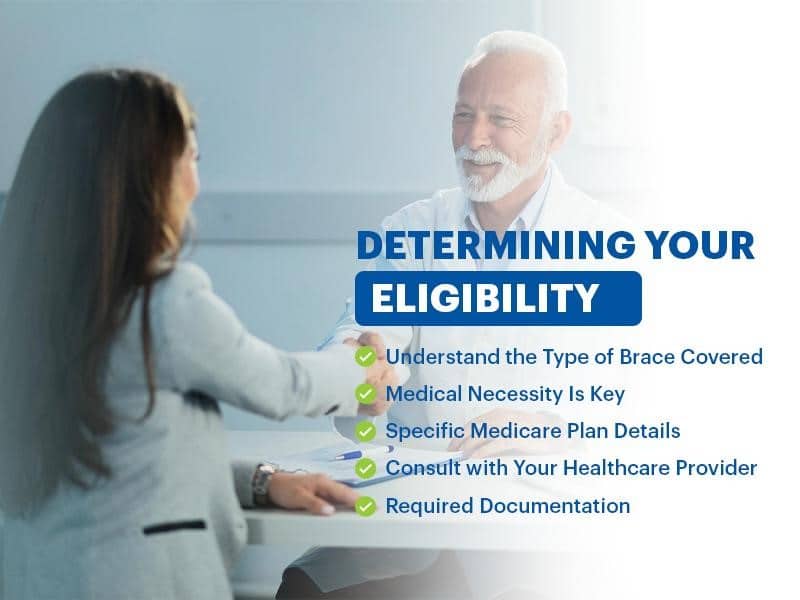Understanding how to navigate the complexities of Medicare can significantly impact your health and wallet, especially when it comes to obtaining necessary braces and devices. This article will guide you through the process of making the most out of Medicare’s provisions for durable medical equipment (DME), such as braces for various body parts.
Understanding Medicare Coverage for Braces
Navigating the nuances of Medicare coverage for braces requires an understanding of the program’s specifics. Under Medicare Part B, braces fall under the category of Durable
Medical Equipment (DME), which includes a wide range of items from wheelchairs to home oxygen equipment — and, of course, braces for various parts of the body.
However, coverage isn’t automatic; there are key criteria that must be satisfied:
1. Medical Necessity: The brace must be deemed medically necessary and prescribed by a healthcare provider participating in Medicare. This means your doctor must document that the brace is needed to treat or manage a diagnosed medical condition.
2. Medicare-Enrolled Physician: The prescription for the brace must come from a physician enrolled in the Medicare program. If your doctor isn’t enrolled, Medicare won’t cover the cost of your brace.
3. Medicare-Approved Supplier: You must obtain your brace from a supplier that is officially enrolled in Medicare. Suppliers who are not enrolled may offer braces that don’t meet Medicare’s standards, leading to a denial of coverage.
4. Equipment Standards: The brace itself must meet certain standards for durability, use in the home, and lifespan (typically, a brace should be able to last for three years of regular use).
By ensuring these conditions are met, Medicare beneficiaries can be confident that they use their coverage effectively when they require a brace for health reasons. Always double-check with your healthcare provider and the equipment supplier to ensure the process goes smoothly and you can receive the support you need without unnecessary out-of-pocket expenses.
Determining Your Eligibility
Before proceeding with a brace purchase, it is crucial to establish your eligibility for Medicare coverage to avoid unexpected costs. Here are steps to help you ascertain if your brace is covered:

1. Understand the Type of Brace Covered: Not all braces are created equal in the eyes of Medicare. For instance, while knee and back braces are commonly covered, other types may not be. Ensure that the type of brace you need is included in Medicare’s list of covered DMEs.
2. Medical Necessity Is Key: Medicare coverage hinges on whether the brace is deemed medically necessary for your condition. Your healthcare provider typically determines this and must be documented as part of your medical records.
3. Specific Medicare Plan Details: Different Medicare plans have varying levels of coverage. While Original Medicare (Part A and Part B) generally covers DME, Medicare Advantage Plans (Part C) may have different rules and coverage limits. Review your plan details to understand your coverage.
4. Consult with Your Healthcare Provider: A discussion with your healthcare provider is the most reliable way to determine if your situation warrants a Medicare-covered brace. They can provide a prescription and documentation justifying the need for a brace, which you will need for Medicare to process your claim.
5. Required Documentation: Be prepared to gather and submit any required documentation proving the brace is necessary. This may include a detailed written order from your doctor, medical history, and relevant test results or records.
By diligently checking these aspects, you can confidently determine your eligibility for a Medicare-covered brace. Always remember that pre-approval may be necessary for certain items, so initiate this process well in advance to ensure you receive your brace when you need it.
Finding the Right Brace
Selecting the appropriate brace is critical in your treatment and recovery journey. Here’s how you can find a brace that meets both your medical and Medicare requirements:
1. Professional Consultation: The first port of call should be your doctor or a specialist in orthotics. These professionals can recommend the type of brace that will best address your condition, offering the necessary support, flexibility, or restriction as needed.
2. Medicare-Approved Devices: Once you have a recommendation, verify that Medicare covers the suggested brace. Your healthcare provider or the supplier should be able to confirm this for you. Remember, the brace must be supplied by a Medicare-approved provider to qualify for coverage.
3. Comfort and Fit: An effective brace should fit well and be comfortable to wear. It should not impede blood flow or cause discomfort. When trying on different braces, walk around, sit down, and perform typical movements you do daily to ensure the brace supports and moves with you as needed.
4. Adjustability and Ease of Use: Choose a brace that is easy for you to put on, take off, and adjust. This is especially important if you have limited dexterity or will use the brace independently.
5. Durability and Maintenance: Consider the materials and design of the brace for durability, especially if you’ll need to wear it long-term. Check how easy it is to clean and maintain since a well-cared-for brace can last longer and perform better.
By carefully considering these factors, you’ll be more likely to find a brace that effectively aids your recovery and is covered by Medicare, ensuring you receive the support you need without undue financial strain.
Navigating the Approval Process
Securing Medicare approval for your brace requires navigating through a specific process. This process can be straightforward if you understand the steps involved and have all the necessary documentation ready. Here’s what you need to do:

1. Doctor’s Prescription: The first step is to obtain a prescription from your doctor. The prescription must indicate the medical necessity for the brace and how it will aid in your treatment or mobility.
2. Documentation of Medical Necessity: Along with the prescription, you’ll need documentation that supports the need for a brace. This could include medical records, a detailed description of your condition, and a treatment plan that outlines how the brace fits into your care.
3. Medicare-Enrolled Supplier: It is crucial that you obtain your brace from a supplier enrolled in the Medicare program. Medicare will only cover your brace if an approved supplier provides it.
4. Submitting the Claim: Once you have your prescription and selected a brace from an approved supplier, the claim must be submitted to Medicare for approval. Typically, the supplier will handle this process, but it’s important to ensure that all paperwork is properly filled out and submitted.
5. Follow-Up: If there’s any delay or issue with the approval process, don’t hesitate to follow up with the supplier or Medicare directly. Sometimes, additional information may be required, or there could be a need to clarify certain aspects of your prescription or medical necessity documentation.
By following these steps and ensuring you have clear, complete documentation, you can navigate the Medicare approval process for your brace with greater ease and confidence.
Read More: How Often Will Medicare Pay for Back Braces?
Keeping Costs Down
To ensure you’re maximizing benefits while minimizing out-of-pocket expenses, consider the following:
● Opt for Medicare-enrolled suppliers.
● Double-check if your Medicare Advantage Plan offers additional coverage.
● Keep abreast of any changes in Medicare policies that might affect coverage.
Maintenance and Replacement
Taking care of your brace is as important as choosing the right one. Proper maintenance can extend the life of the brace, ensure its effectiveness, and help you avoid additional out-of-pocket expenses. Furthermore, understanding Medicare’s rules about replacement coverage will help you manage your benefits more effectively. Here’s what you need to know about maintaining and replacing your Medicare-approved brace:
Maintenance Tips
1. Follow the Manufacturer’s Care Instructions: Every brace comes with specific instructions for care. These guidelines ensure the brace maintains its structural integrity and therapeutic value.
2. Regular Cleaning: Keep your brace clean according to the care instructions. Mild soap and water are sufficient for many braces, but check if your brace has special requirements.
3. Inspect Regularly: Periodically inspect your brace for signs of wear, such as frayed straps or loose fittings. Addressing these issues early can prevent further damage.
4. Proper Storage: When not used, store your brace in a dry, cool place away from direct sunlight to prevent material degradation.
5. Avoid Unnecessary Strain: Use your brace only as intended. Extra strain from activities outside its design can lead to premature wear.
Replacement Rules
1. Understand Coverage Frequency: Medicare typically covers the replacement of a brace if it’s worn out. The allowable replacement period varies, but it’s usually after a brace cannot be fixed.
2. Documenting the Need for Replacement: If your brace is lost, stolen, or damaged beyond repair, you’ll need to provide Medicare with a reason for the replacement.
3. Repair Before Replacement: If possible, repair parts of the brace before seeking a replacement. Medicare may cover repairs up to the cost of replacing the item.
4. Keep Receipts and Records: Maintain a file with all your receipts, prescriptions, and any communication with Medicare regarding your brace. This can serve as proof of the brace’s age and condition if you need a replacement.
5. Consult Your Supplier: Before making any decisions, talk to your Medicare-approved supplier about your options for repair or replacement.
By taking an active role in the care and maintenance of your brace, you can ensure you’re getting the most out of your Medicare benefits.
Conclusion
Making the most out of Medicare for braces and other devices requires a proactive approach. Be informed about your plan, communicate openly with your healthcare providers, and stay up-to-date on Medicare’s terms and conditions. By doing so, you can maximize your benefits, reduce your expenses, and focus on what’s most important — your health.







